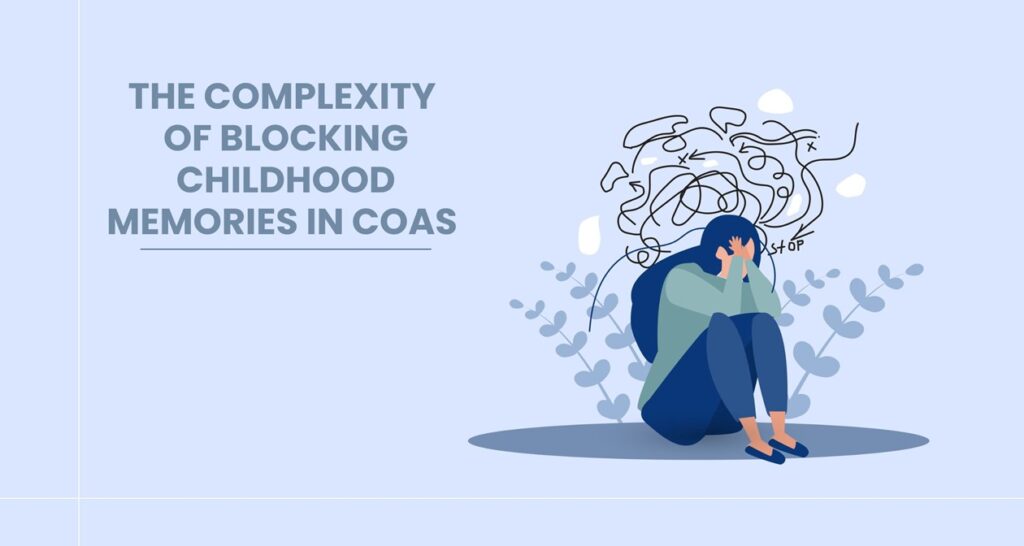For COAs – children impacted by the disease of addiction in their families – the household environment can often be unpredictable, stressful, and emotionally charged. In response to these conditions, some COAs may unconsciously block out memories from their childhood. This psychological phenomenon, often referred to as repressed or dissociative amnesia, serves as a coping mechanism to shield the individual from emotional pain or trauma. Understanding the dynamics and implications of this process is crucial for healing and recovery.
Why Do Some COAs Block Memories?
Psychological Protection: For many COAs, blocking memories serves as a defense mechanism. The young mind, unable to cope with the immediate emotional or physical turmoil, may suppress memories to protect itself from psychological stress or harm.
Dissociation: During particularly traumatic events, dissociation can occur. This is a process where a person mentally removes themselves from a painful situation. In severe cases, this can lead to segments of time being lost or specific memories being blocked, as the mind attempts to distance itself from the trauma.
Emotional Overload: Chronic exposure to stress and conflict can overwhelm a child’s cognitive capacities. The brain may respond by selectively forgetting experiences that are too painful to integrate into their conscious awareness.
The Impact of Blocking Memories
Emotional Disconnect: Individuals who block out significant portions of their childhood may experience a sense of emotional numbness or detachment not only from their past but also in current relationships. This disconnect can hinder their ability to form or maintain close relationships.
Delayed Psychological Issues: Suppressed memories do not erase the trauma’s impact; they only obscure it from consciousness. Issues may manifest later as anxiety, depression, or dysfunctional coping mechanisms like substance abuse.
Identity Confusion: Having gaps in one’s personal history can lead to confusion about one’s identity and worth. COAs might struggle with self-esteem and a coherent sense of self, which are foundational to personal development.
Approaches to Healing
1. Professional Therapy Engaging with a mental health professional specializing in childhood trauma and family issues related to addiction can be beneficial. Therapeutic approaches like cognitive-behavioral therapy (CBT), Eye Movement Desensitization and Reprocessing (EMDR), and psychodynamic therapy can help individuals safely explore and reintegrate repressed memories.
2. Gradual Exposure In a controlled therapeutic setting, gradually revisiting suppressed memories can help individuals process and accept their past experiences, reducing their emotional power. This should be done carefully to avoid re-traumatization.
3. Support Groups Participating in support groups with others who have had similar experiences can provide a sense of community and understanding. Support programs like Adult Children of Alcoholics (ACA), Al-Anon, and NACoA’s ACOA Education and Discussion Group offer a safe space for sharing and healing.
4. Mindfulness and Meditation These practices can help individuals develop a greater awareness of their thoughts and feelings, including those related to suppressed memories. Mindfulness encourages living in the present moment and can gradually decrease the intensity of negative emotions tied to past memories.
5. Creative Expression Art, music, writing, and other creative outlets offer alternative ways for expressing feelings and thoughts that may be difficult to articulate. These activities can provide both a distraction and a form of personal expression that aids in processing complex emotions.
While blocking out painful childhood memories can serve as a temporary refuge from emotional pain for COAs, it is not a solution. Ultimately, addressing these buried memories in a supportive, therapeutic environment is crucial for long-term healing and emotional resilience. Understanding the underlying causes and exploring these memories can pave the way for a more integrated and fulfilling life.
Some additional information and references that can enhance understanding and offer evidence-based insights on the topics discussed:
1. The Body Keeps the Score: Brain, Mind, and Body in the Healing of Trauma by Bessel van der Kolk
This book is a seminal resource in understanding trauma and its physical and psychological effects. Van der Kolk explores mechanisms like dissociation and memory suppression as responses to trauma.
2. Trauma and Recovery: The Aftermath of Violence–from Domestic Abuse to Political Terror by Judith Herman
Herman’s work provides foundational insights into the understanding of trauma, including the impact of growing up in a chaotic, abusive environment. She discusses the process of dissociation and the long-term impact of traumatic memories.
3. Adult Children of Alcoholics by Janet G. Woititz
This book specifically addresses the experiences of children of alcoholics and offers a thorough exploration of the common traits and behaviors that manifest in adulthood, providing context for why and how traumatic memories might be suppressed.
4. Dissociative Identity Disorder Sourcebook by Deborah Bray Haddock
Though specifically about dissociative identity disorder, this book provides useful insights into dissociation as a broader mechanism, which can include memory suppression in response to trauma.
5. Scientific journals such as the Journal of Traumatic Stress, Psychology of Addictive Behaviors and Child Abuse & Neglect often publish research studies on the effects of childhood trauma, including the role of memory in psychological health and recovery.
